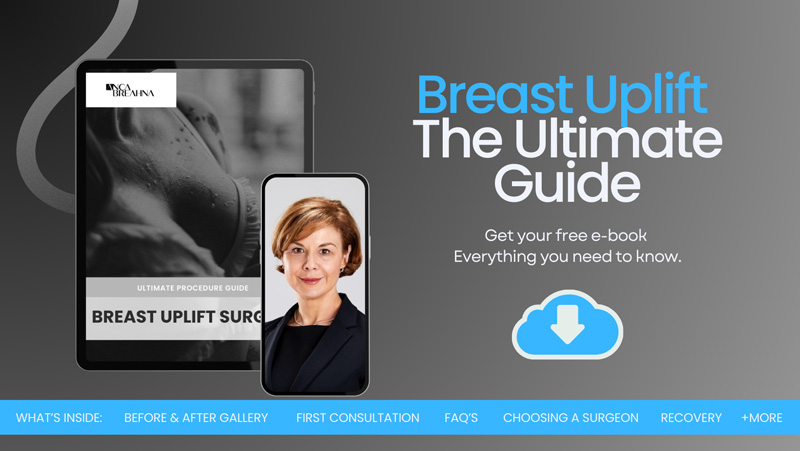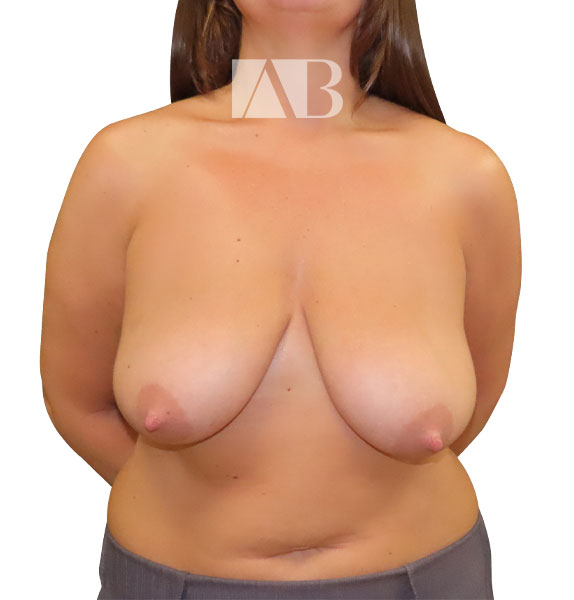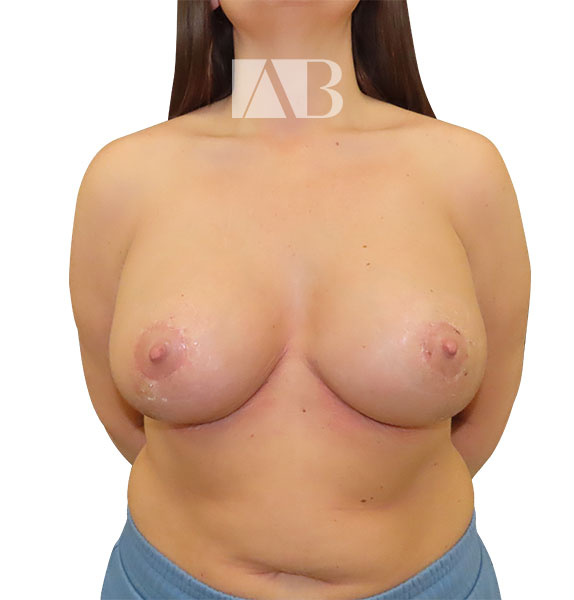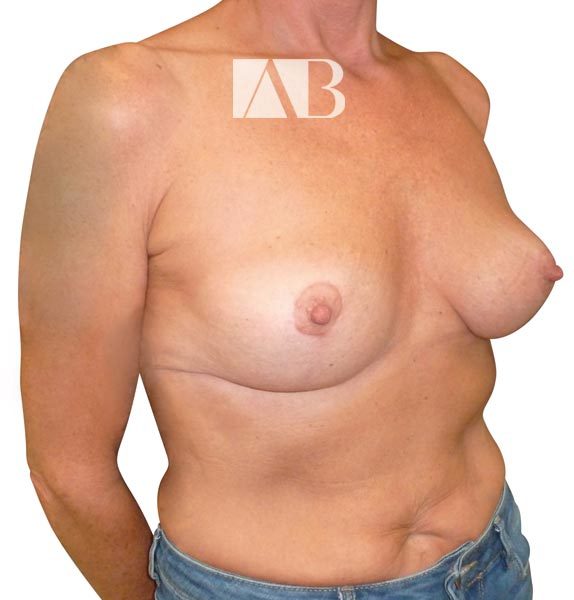
Miss Anca Breahna, Consultant Plastic & Reconstructive Surgeon in Chester, UK, understands that concerns about sagging breasts affect many individuals. Whether due to ageing, weight fluctuations, pregnancy, or lifestyle habits, sagging breasts – medically known as breast ptosis – can impact self-confidence and body image. Fortunately, while some degree of sagging is inevitable as we age, there are several proactive steps to maintain breast firmness and support long-term breast health. Here, Miss Breahna provides expert insights into the causes of sagging breasts and the most effective strategies to prevent or correct them. Whether you are looking for non-invasive solutions or considering surgical options, this comprehensive resource will help you make informed decisions tailored to your needs.
Take our Plastic Surgery Quiz to find out if you’d be a good candidate for cosmetic surgery.
Understanding Sagging Breasts
What Are Sagging Breasts?
Breast ptosis, commonly referred to as sagging breasts, is a condition where the breasts lose their youthful shape and firmness, leading to a downward shift in breast tissue. This occurs due to a combination of factors, including reduced skin elasticity, weakened structural support, and natural ageing. The severity of sagging varies from mild to severe, depending on an individual’s genetics, lifestyle, and medical history.
Sagging breasts can be categorized into different grades:
- Mild Ptosis: The nipple remains above the inframammary fold but sits lower than it did in youth.
- Moderate Ptosis: The nipple aligns with or slightly falls below the inframammary fold.
- Severe Ptosis: The nipple points downward and sits significantly below the fold.
What Causes Sagging Breasts?
1. Natural Ageing and Skin Elasticity Loss
As individuals age, their skin naturally produces less collagen and elastin – two essential proteins responsible for skin structure and firmness. Without adequate collagen, the skin loses its ability to remain taut, leading to laxity and eventual sagging. The loss of skin elasticity is further exacerbated by the effects of gravity, which continuously pulls the breast tissue downward over time.
Additionally, hormonal changes during menopause contribute to the loss of glandular breast tissue, replacing it with fatty tissue that lacks firmness. These changes make sagging more noticeable as women age, particularly after the age of 40.
2. Pregnancy and Breastfeeding
The physical and hormonal changes associated with pregnancy significantly impact breast structure. As the body prepares for breastfeeding, the breasts enlarge due to increased glandular tissue and milk production. This expansion stretches the skin and the internal Cooper’s ligaments, which provide structural support to the breasts.
Following childbirth, once milk production ceases, the breasts often shrink back to their pre-pregnancy size. However, because the skin has been stretched, it may not fully retract, leading to a deflated or sagging appearance. While breastfeeding itself is not directly responsible for sagging, the repeated stretching and shrinking cycles caused by pregnancy-related changes contribute to breast ptosis over time.
3. Weight Fluctuations and Rapid Weight Loss
Significant weight gain causes the breasts to expand, stretching the skin and weakening its elasticity. Conversely, rapid weight loss can result in a loss of breast volume, leaving behind excess loose skin. These fluctuations cause the breasts to lose their natural shape and firmness.
Women who engage in extreme dieting, crash diets, or undergo rapid weight-loss procedures such as bariatric surgery may experience more pronounced breast sagging due to the sudden reduction in fatty tissue without sufficient time for the skin to contract. Maintaining a stable weight is crucial to preserving breast firmness.
4. Genetics and Natural Breast Composition
Just as genetics influence height, hair color, and body shape, they also determine breast structure, density, and skin elasticity. Some individuals inherit firmer, more resilient skin, while others may have a genetic predisposition to weaker skin and ligaments, making them more prone to sagging.
Breast composition also plays a role – breasts with a higher ratio of glandular tissue tend to maintain their shape better, whereas breasts composed primarily of fatty tissue are more susceptible to sagging over time.
5. Lifestyle Habits That Affect Breast Firmness
- Smoking: Nicotine and other chemicals in cigarettes damage collagen and elastin, leading to premature skin ageing. Long-term smoking accelerates breast sagging by reducing blood flow to the skin, depriving it of essential nutrients needed for repair and elasticity.
- Sun Exposure: Ultraviolet (UV) radiation weakens the skin’s elasticity, causing it to lose firmness. Consistently exposing the chest area to direct sunlight without sunscreen can accelerate the ageing process, leading to early breast sagging.
- Poor Posture: Slouching causes the shoulders to roll forward, pushing the breasts downward and making them appear less perky. Over time, poor posture can contribute to sagging by putting additional strain on the supporting ligaments.
- Wearing the Wrong Bra Size: Without proper support, particularly during physical activities, the Cooper’s ligaments stretch, leading to long-term sagging. A well-fitted bra is essential to maintain breast shape and prevent unnecessary strain on breast tissues.
Download Anca Breahna’s Breast Uplift Guide

How to Prevent Sagging Breasts Naturally
1. Maintain a Stable, Healthy Weight
Avoiding drastic weight fluctuations is one of the best ways to prevent sagging breasts. Consuming a balanced diet rich in protein, healthy fats, and vitamins supports skin elasticity and firmness. Nutrients such as vitamin C help stimulate collagen production, while omega-3 fatty acids found in fish and nuts contribute to supple, hydrated skin.
Regular exercise plays a crucial role in maintaining an ideal weight and preserving breast shape. Low-impact activities like yoga and pilates help maintain muscle tone, while strength training ensures proper support for the breasts.
2. Wear a Supportive, Well-Fitted Bra
A high-quality, properly fitted bra provides essential support to the breast tissue, particularly during exercise and high-impact activities. A supportive bra prevents excessive movement that could stretch the ligaments and lead to sagging. Sports bras, in particular, are crucial for maintaining breast structure during running, jumping, or weightlifting.
Women with larger breasts may require bras with added structural reinforcements, such as wide straps and underwire, to minimize strain on the skin and ligaments. Regularly replacing worn-out bras ensures continued support.
3. Exercise to Strengthen Chest Muscles
While exercise cannot directly lift sagging breasts, strengthening the underlying pectoral muscles creates a firmer, more lifted appearance. Some of the most effective exercises include:
- Push-ups: These work the pectoral muscles, shoulders, and triceps, promoting upper-body strength and improving breast support.
- Dumbbell Chest Presses: Lifting weights while lying on a bench strengthens the chest, helping to define the area beneath the breasts.
- Incline Chest Flyes: This movement targets the upper chest, enhancing muscle tone and posture.
FAQs About Sagging Breasts
Can sagging breasts be reversed naturally?
While lifestyle changes such as regular exercise, skin care, and weight management can improve the overall appearance of the breasts, they cannot fully reverse significant sagging. For individuals experiencing moderate to severe sagging, surgical options such as a breast uplift (mastopexy) may be necessary.
Does sleeping without a bra contribute to breast sagging?
There is no scientific evidence to suggest that sleeping without a bra causes or prevents sagging. Breast sagging is primarily influenced by genetics, ageing, and lifestyle factors rather than bra usage during sleep.
How does weight loss impact breast firmness?
Losing weight rapidly can lead to a reduction in breast volume, leaving excess loose skin that contributes to sagging. Gradual weight loss, combined with strength training exercises, can help maintain skin elasticity and muscle support.
Are there any non-surgical treatments to prevent or correct sagging breasts?
Yes, non-surgical treatments such as radiofrequency skin tightening, laser therapy, and microneedling can improve skin tone and firmness. However, these treatments are most effective for mild sagging and may not provide the same results as a surgical breast uplift.
Can exercise lift sagging breasts?
Exercise strengthens the pectoral muscles beneath the breasts, which can improve their overall appearance and provide better support. However, exercise alone cannot tighten stretched skin or restore breast position after significant sagging.
Does pregnancy always lead to sagging breasts?
Not necessarily. While pregnancy-related breast changes can contribute to sagging, maintaining a stable weight, wearing supportive bras, and practicing good skin care can help minimize the effects.
How can I tell if I need a breast uplift?
If your nipples sit below the inframammary fold or point downward, a breast uplift may be beneficial. A consultation with Miss Anca Breahna, Consultant Plastic & Reconstructive Surgeon in Chester, UK, can help determine the best approach based on your specific concerns and aesthetic goals.
Medical References
- Saggy Breasts: Weight Loss, Exercises, and Breastfeeding – Healthline – https://www.healthline.com/health/saggy-breasts
- The Six Common Causes Of Breast Sagging – Piedmont Healthcare – https://www.piedmont.org/living-real-change/6-causes-of-breast-sagging3
- Saggy breasts: Causes and solutions – MedicalNewsToday – https://www.medicalnewstoday.com/articles/saggy-breasts
- What to Know About Sagging Breasts – WebMD – https://www.webmd.com/women/what-to-know-about-sagging-breasts
- Bras Make Breasts Sag, 15-Year Study Concludes – MedicalNewsToday – https://www.medicalnewstoday.com/articles/259073
- Female Sagging Breast Dynamic 3D Displacement Study – SAGE Journals – https://journals.sagepub.com/doi/full/10.1177/15589250211018196
Final Thoughts – Taking the Next Steps
Understanding the causes of sagging breasts and taking proactive measures to maintain skin elasticity can help preserve a youthful breast shape. For those considering professional solutions, Miss Anca Breahna, Consultant Plastic & Reconstructive Surgeon in Chester, UK, offers expert advice and advanced surgical procedures to restore breast firmness and contour.
To learn more about treatment options or schedule a personalized consultation, visit Miss Breahna’s Chester-based clinic for a thorough evaluation. With tailored solutions and cutting-edge techniques, you can achieve natural, long-lasting results and regain confidence in your appearance.
Further Reading about Droopy Breasts with Consultant Plastic Surgeon Anca Breahna
- Read Anca’s Procedure Page on Breast Uplift – Mastopexy
- Read Anca’s Blog Page on How to Get Perky Breasts and Upper Pole Fullness
- Read Anca’s Blog Page on Breast Uplift and the “Pencil Test” for Breasts
- Read Anca’s Blog Page on How to Fix Saggy Breasts – Breast Uplift, Breast Implants or Both
- Read Anca’s Blog Page on Solutions for Saggy Breasts
- Read Anca’s Blog Page on Natural Solutions to Stop Breast Sag
- Read Anca’s Blog Page on How to Get Firmer Breasts




 Ms Anca Breahna, PhD, MSc, FEBOPRAS, FRCS (Plast) is a highly regarded Consultant Plastic Surgeon specialising in the field of Aesthetic and Reconstructive Plastic Surgery. Anca performs a range of
Ms Anca Breahna, PhD, MSc, FEBOPRAS, FRCS (Plast) is a highly regarded Consultant Plastic Surgeon specialising in the field of Aesthetic and Reconstructive Plastic Surgery. Anca performs a range of 